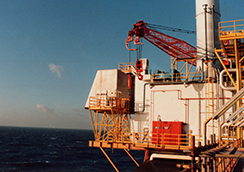Fitness for Service Evaluation
Fitness for Service assessments provide useful economic and safety benefits to end-users and operators. These benefits include:
- ensuring the safety of plant personnel and the public while older equipment continues to operate, and
- helping to optimize maintenance and operation of existing facilities to maintain the availability of older plants and enhance long-term viability.
“Complete fitness-for-service, mechanical-integrity, and remaining-life services.”
The Hendrix Group Inc. has been providing corrosion consulting, corrosion prevention, and corrosion-control services for more than 35 years. Our objectives are:
- to provide a high quality of service at a reasonable price
- to develop practical solutions to clients' corrosion problems
- to work with our clients as a team.

Fitness for Service and API 579
Fitness for Service is defined as the ability to demonstrate the structural integrity of an in-service component containing a flaw. API 579, Fitness for Service is rapidly becoming the standard for conducting fitness-for-service assessments. API 579 describes standardized fitness-for-service techniques for pressurized equipment used in industry. It supplements the inspection and assessment techniques in API 510, API 570 and API 653.
Uses of the API 579 procedure
The procedures can be used for:
- evaluating and re-rating pressure vessels designed and constructed to the ASME Boiler and Pressure Vessel Code
- piping systems designed and constructed to the ASME B31.3 Piping Code
- above ground storage tanks designed and constructed to API 650 and API 620.
Providing complete Fitness for Service assessments
The Hendrix Group routinely conducts fitness-for-service assessments of pressure vessels, piping systems and storage tanks using API 579 guidelines. Our engineers and associated strategic partners can provide complete fitness-for-service, mechanical integrity and remaining-life services. These services include field inspections and data collection, laboratory mechanical and chemical testing, and cost-effective engineering solutions.
Typical scenarios requiring Fitness for Service assessment include:
- Assessment of equipment for general metal loss
- Assessment of equipment for local metal loss
- Assessment of equipment for brittle fracture
- Assessment of equipment for pitting corrosion
- Assessment of equipment for blisters and laminations
- Assessment of equipment for crack-like flaws
- Assessment of fire damage
Example fitness-for-service projects
The following projects are examples of fitness for service projects that The Hendrix Group has conducted:
API 579 Section 9 Assessment of Crack-like Flaws - Electrical transmission equipment in Argentina
Evaluate fitness-for-service assessment of type 304 stainless-steel compression fittings containing surface and subsurface forgings flaws that supported high-voltage, free-standing, trussed transmission line towers in Argentina. The assessment included investigations into hydrogen embrittlement susceptibility, finite element and fracture mechanics modelling, and statistical sampling techniques—$80K.
Underground gas pipeline
Evaluate fitness-for-service and remaining-life study of an underground gas gathering pipeline that failed due to rupture at a groove-like flaw associated with an ERW weld. General internal thinning, blisters and hydrogen-charged material toughness properties were pertinent to the investigation. Corrosion-rate modelling due to wet CO2 was performed to assess safe allowable internal pressures—$7K.
Storage tanks in a high population density area
Evaluate the existing condition and fitness-for-service of API 650 aboveground storage tanks in a high population density area. Maximum fill-height calculations were conducted based on localized shell plate thinning—$20K.
Retired ethylene plant evaluation
Evaluate fitness-for-service assessment of more than two hundred pressure-vessel and piping systems in a mothballed ethylene plant. Critical degradation mechanisms evaluated included: (1) general metal loss, (2) H2S cracking, (3) wet CO2 corrosion, (4) high-temperature sulfidation, and (5) brittle fracture evaluations—$20K.
API 579 Section 3 Brittle Fracture Assessment
Conducted Level 2 fitness-for-service assessment of pressure vessels based on brittle fracture susceptibility resulting from a depressurization event—$20K.
API 579 Sections 4, 5 and 6 Metal Loss Assessment
Conducted a Level 2 fitness for service evaluation of storage drums due to external metal loss from corrosion under insulation (CUI).